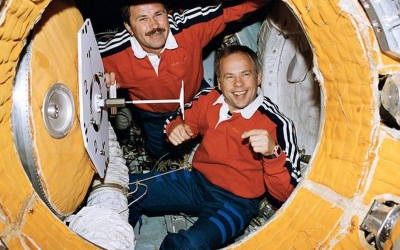
Space stories are best remembered for their successes. The emergencies and failures are often reduced to footnotes in space history, even if the learnings from them are also valuable. One such emergency that might have even cost human lives happened during the Soyuz TM-9 expedition.
The ninth expedition to the Soviet/Russian space station Mir, Soyuz TM-9 had a two-member crew in the form of Soviet and Russian cosmonauts Anatoly Solovyov and Aleksandr Balandin. Launched from the Baikonur Cosmodrome on February 11, 1990, the Soyuz TM-9 docked with the orbital station Mir on February 13.
Thermal blankets damaged The departing crew of TM-8 observed that three of the eight thermal insulation blankets on TM-9’s descent module were damaged. There were fears that the damaged insulation could block optical navigation sensor or even lead to overheating or cooling that might cause an electrical short. As a result, a spacewalk that was previously unscheduled was forced on the cosmonauts.
For starters, the Mir space station was manoeuvred so as to keep TM-9 facing the sun and hence have the temperature stabilised. The damage to the blankets, however, required special tools and also an EVA (extra-vehicular activity) ladder to reach the impaired area.
These materials arrived with the long-awaited, much-delayed Kristall module, which docked at Mirs front port on June 10 and was relocated to the port opposite Mirs Kvant 2 module the next day. While Solovyov and Balandin were initially scheduled to return to Earth at the end of July, their mission was extended by 10 days to enable them to activate Kristall’s systems and perform the EVA to repair TM-9’s damaged blankets.
Learning on the go
To add to the existing issues, Solovyov and Balandin had not been trained to perform an EVA. In such a situation, the duo were asked to train using a videotape that had been sent from Earth on a Progress spacecraft. Additionally, they also observed televised practice sessions.
On July 17, the cosmonauts exited through the Kvant 2 hatch and began the repair mission. Using the ladders to reach the damaged site, they observed that the TM-9 descent module remained in excellent condition save for the thermal problem.
As the thermal blankets had shrunk to a stage where it was impossible to reattach them, the cosmonauts resorted to their contingency plan by folding two of the three blankets in half and stowing the torn blankets away from the sensor’s line of sight. A time-intensive exercise, it took them nearly six hours, meaning that they were well behind their schedule and fast approaching the rated endurance of their spacesuits.
Back in the Kvant 2 airlock, they realised that the outer hatch wouldn’t close. Apparently, they had opened the hatch before the chamber had fully depressurised when they had stepped out. As the airlock wasn’t completely evacuated of air, the door now didn’t close and its hinges were damaged.
Emergency hatch helps out
The central compartment of Kvant 2 was designed to serve as an emergency hatch. With time running out, Solovyov and Balandin depressurised this compartment, moved into it and then re-pressurised it before entering the pressurised portion of Mir. Their unscheduled EVA had lasted 7 hours and 16 minutes.
On July 25, the duo performed another EVA, this time to repair the hatch and secure their ladders. Following several failed attempts to close the outside hatch from inside. They televised images before going ahead to secure the ladders. In the end, a short-term fix was managed when a portion of the hinge cover, which had broken and lodged between the hatch and its frame, was removed. The second EVA, which lasted 3 hours and 31 minutes, proved to be successful as the hatch was easier to close and seal after this.
Solovyov and Balandin’s 179-day mission came to an uneventful end on August 9 when Soyuz TM-9 landed without incident at a predetermined area 72 km north-east of the city of Arkalyk, now in Kazakhstan. The duo had 130 kg of experimental results and industrial products to show for their efforts, apart from an egg that was laid by a quail aboard Soyuz TM-10 while en route to the space station.
Picture Credit : Google




